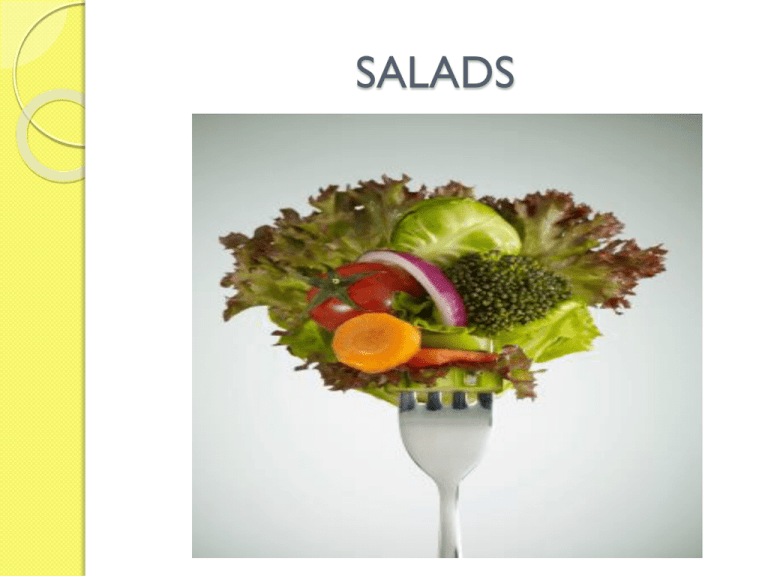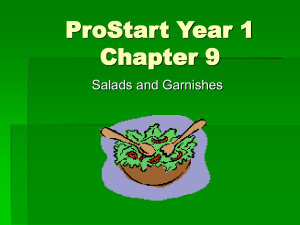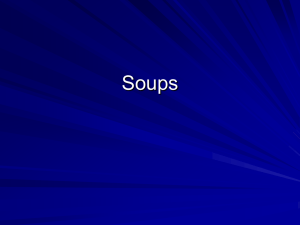SALADS File
advertisement

SALADS LEARNING OBJECTIVES At the end of this session the student will know the following. 1. Define salads 2. Types of salads 3. The categories of salads 4. Guidelines for salads 5. Salad bars and buffet service DEFINITION OF SALADS Salads are a category of dishes whose prototype is raw vegetables served with a sauce or dressing including oil and an acid as a light savory dish, with a minimum of three ingredients. Salads also include a variety of related dishes, including ones with cold cooked vegetables, including grains and pasta; ones which add cold meat or seafood; sweet dishes made of cut-up fruit; and even warm dishes. Though the prototypical salad is light, a dinner salad can constitute a complete meal. Green salads include leaf lettuce and leafy vegetables with a sauce or dressing. Most salads are served cold, although some, such as south German potato salad, are served warm. Salads are generally served with a dressing, as well as various garnishes such as nuts or croutons, and sometimes with the addition of meat, fish, pasta, cheese, eggs, or whole grains. TYPES OF SALADS 1. Appetizer Salads 2. Accompaniment Salads 3. Main Course Salads 4. Separate-Course Salads 5. Dessert Salads APPETIZER SALADS Appetizer salads should stimulate the appetite with fresh, crisp ingredients; a tangy, flavourful dressing; an attractive, appetizing appearance. The portion size should not be too large but substantial enough to serve as a complete course. The combination of ingredients should be interesting, not dull or trite eg. Cheese, ham, salami, shrimp and crabmeat in small quantities add eye appeal. Attractive arrangement and garnish are important to stimulate the appetite. ACCOMPANIMENT SALADS Accompaniment salads are served with the main course. Accompaniment salads must balance and harmonize with the rest of the meal. Should be light and flavourful, not too rich. Eg.Vegetable salads are good choices. Combination salads with a variety of elements are appropriate accompaniments to sandwiches. MAIN-COURSE SALADS Main-course salads should be large enough to serve as a full meal and should contain a substantial portion of protein eg. Meat, poultry and seafood salads, eggs and cheese. Main-course salads should offer enough variety on the plate to form a balanced meal, both nutritionally and in flavours and textures. In addition to the protein, a variety of vegetables, greens and/or fruits should be offered. Attractive arrangements and good balance are important. SEPARATE-COURSE SALADS Many fine restaurants serve a refreshing light salad after the main course. The purpose is to cleanse the palate after a rich dinner and to refresh the appetite and provide a pleasant break before dessert. Separate-course salads must be very light with a few delicate greens lightly dressed with vinaigrette. Fruit salads are popular choices. DESSERT SALADS Dessert salads are usually sweet and may contain items such as fruits, sweetened gelatin, nuts and cream. Dessert salads are best served as a dessert or part of a buffet or party menu. INGREDIENTS USED IN SALADS 1. Salad Greensiceberg lettuce, romaine lettuce, spinach etc 2. Raw vegetablesavocado, broccoli, carrots, tomatoes etc 3.Vegetables, Cooked, canned and pickledolives, beets, corn, cucumber pickles etc 4. Starches- potatoes, grains, croutons, pasta etc 5. Fruits, fresh, cooked, canned or frozenapples, coconut, melons, pears etc 6. Protein foodsmeats, poultry, fish and shellfish, cheese etc 7. Miscellaneousgelatin, nuts STRUCTURE OF A SALAD The four basic parts of a salad are: 1. Base or Underliner 2. Body 3. Garnish 4. Dressing NB: All salads have body and most have dressing but base and garnish are parts of only some salads. BASE AND UNDERLINER Leafy greens usually form the base of the salad. They add greatly to the appearance of some kinds of salads. Cup-shaped leaves of iceberg or Boston lettuce make attractive bases. They give height to salad and help to confine loose pieces of food. A layer of loose, flat leaves (such as romaine, loose-leaf, or chicory) or of shredded lettuce may be used as a base. BODY This is the main part of the salad. Eg. A mixture of greens, starches, vegetables and protein items. GARNISH A garnish is and edible decorative item that is added to a salad to give eye appeal and sometimes as well flavour. Garnish should harmonize with the rest of the salad ingredients. It may be mixed with the other salad ingredients or added at the end. Often the main ingredients of a salad form an attractive pattern in themselves and no garnish is necessary. A wide range of fruits, vegetables and protein foods may be used as garnish. DRESSING Dressing is a seasoned liquid or semi-fluid added to the body of a salad for flavour, tartness, spiciness and moistness. The dressing should harmonize with the salad ingredients. Eg. tart dressings for green and vegetable salads; lightly sweetened dressings for fruit salads; light dressings for delicate greens. Dressings may be added at service time, served separately for the customer to add or mixed with the ingredients ahead of time. GUIDELINES FOR ARRANGING SALADS 1. Keep the salad off the rim of the plate 2.Strive for a good balance of colors 3. Height helps make a salad attractive 4. Cut ingredients neatly 5. Make every ingredient identifiable 6. Keep it simple CATEGORIES OF SALADS 1. Green salads 2.Vegetable, grain and legume salads 3. Bound salads 4. Fruit salads 5. Composed salads 6. Gelatin salads GREEN SALADS Salad greens must be fresh, clean, crisp, cold and well drained. Moisture and air are necessary to keep greens crisp. 1. Leaves wilt because they lose moisture. Crispness can be restored by washing and refrigeration. 2. Air circulation is essential for the greens to breathe. VEGETABLE, GRAIN AND LEGUME Vegetable salads are salads whose main ingredients are vegetables. Eg. celery, carrots, cucumbers, tomatoes and radishes. Some are cooked and chilled before including in the salads; green beans, beets, artichokes and asparagus. Starchy items such as grains and dried legumes can also form the body of a salad. Raw or cooked vegetables are usually added to the starch item to enhance the colour, flavour and nutritional balance of the salad. BOUND SALADS Bound salads are mixtures of foods held together, or bound with a dressing, usually a thick dressing such as mayonnaise. The term bound is used for mixtures of cooked protein, starch and vegetable items with mayonnaise such as chicken salad, tuna salad, egg salad, potato and pasta salad etc. FRUIT SALADS Fruit salads have fruits as their main ingredients. They are popular as appetizer salads, as dessert salads and as part of combination luncheon plates often with a scoop of cottage cheese or other mild tasting protein food. COMPOSED SALADS Composed salads are salads made by arranging two or more ingredients attractively on a plate. They are called composed because the components are arranged on the plate rather than being mixed together. One or more elements may be mixed or tossed salads, but the individual mixed salads are arranged on the plate with other components for the final presentation. Composed salads are more elaborate and substantial in size and are usually served as main courses or first courses. GELATIN SALADS Gelatin salads have a distinguished history. Their ancestors are aspics, the highly ornamented appetizers and elaborate buffet pieces made with meat and fish stocks rich in natural gelatin extracted from bones and connective tissue. Aspics are part of the glory of classical cuisine and still an important part of modern buffet work. SALAD BARS AND BUFFET SERVICE Salad bars are frequent fixtures in restaurants. Diners enjoy customizing their own salads with selections from a large bowl of greens, smaller containers of assorted condiments and a variety of dressings. Salad bars take pressure off the dining room staff during service. POINTS TO KEEP IN MIND FOR SALAD BARS 1. Keep the salad bar attractive and well stocked from the beginning until the end of service. 2. Keep the components simple but attractive. 3. Select a variety of condiments to appeal to a variety of tastes. Two types of salad bar condiments: a. Simple ingredients b. Prepared salads- three bean salads, macaroni salads POINTS CONT’D 4. Arrange the salad bar in this order: a. Plates b. Mixed greens c. Condiments d. Dressings e. Crackers, breads etc. 5. Make sure set up conforms to your state health department regulations. 6. Portion control can be achieved by selecting the right size plates, condiment servers and dressing ladles. FURTHER READING CHAPTER 21 IN THE PROFESSIONAL COOKING



